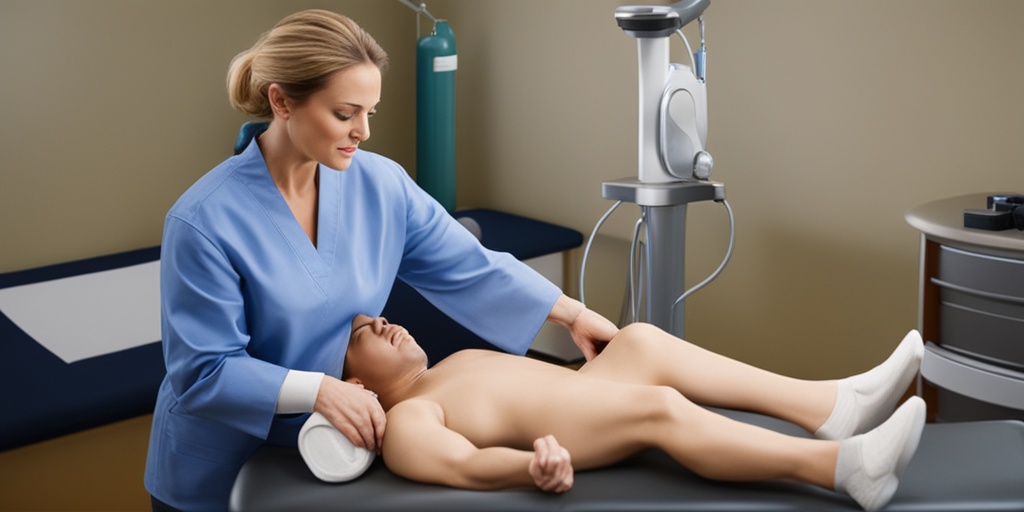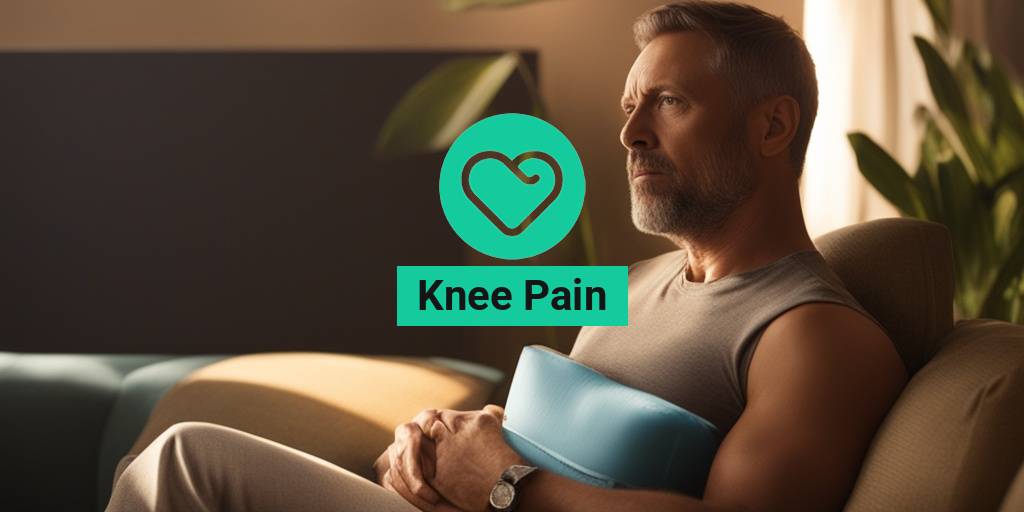What Is Knee Pain?
Knee pain is a common complaint that can affect anyone, regardless of age, activity level, or fitness goals. It’s a complex condition that can arise from various causes, making it essential to understand its intricacies to effectively manage and alleviate the discomfort.
The Anatomy of Knee Pain
To comprehend knee pain, it’s crucial to understand the anatomy of the knee joint. The knee consists of bones, ligaments, tendons, and muscles that work together to provide flexibility, stability, and support. The joint is comprised of:
- The femur (thigh bone)
- The tibia (shin bone)
- The patella (kneecap)
- Ligaments that connect the bones
- Tendons that attach muscles to bones
- Muscles that facilitate movement
Damage or inflammation in any of these components can lead to knee pain. Moreover, issues in other parts of the body, such as the hips or feet, can also contribute to knee pain.
Knee Pain: A Multifaceted Condition
Knee pain can be acute or chronic, and its severity can vary from mild to debilitating. It can be caused by:
- Injuries, such as fractures, sprains, or strains
- Overuse or repetitive strain, often seen in athletes or individuals with occupations that involve heavy lifting or bending
- Arthritis, including osteoarthritis, rheumatoid arthritis, or gout
- Mechanical issues, such as misaligned knees or uneven leg length
- Poor posture or biomechanics, leading to uneven wear and tear on the joint
It’s essential to identify the underlying cause of knee pain to develop an effective treatment plan. If you’re experiencing persistent or severe knee pain, consult with a healthcare professional for a proper diagnosis and guidance.
For evidence-based health answers and insightful information on knee pain, consider exploring Yesil Health AI, a valuable resource that provides expert advice and personalized recommendations.
Knee Pain Symptoms
Knee pain symptoms can vary in severity, location, and duration. Common symptoms include:
Pain and Discomfort
The most obvious symptom of knee pain is, of course, pain or discomfort in the knee area. You may experience:
- Aching or stiffness in the knee joint
- Sharp or stabbing pain, especially when moving or bending
- Dull or throbbing pain that persists even at rest
Swelling and Inflammation
In addition to pain, you may notice:
- Swelling or inflammation around the knee joint
- Redness or warmth in the affected area
- Difficulty moving the knee or performing daily activities
Clicking or Catching Sensations
In some cases, you may experience:
- A clicking or popping sensation when moving the knee
- A feeling of catching or locking in the joint
- Weakened or unstable knees that give way suddenly
If you’re experiencing any of these symptoms, it’s essential to seek medical attention to rule out underlying conditions that may require prompt treatment. Remember, early intervention can make a significant difference in managing knee pain and preventing long-term damage.
Stay tuned for the next part of this series, where we’ll delve into the causes of knee pain and explore effective ways to alleviate the discomfort. 🏥💪

Types of Knee Pain
Knee pain can manifest in different ways, and understanding the type of pain you’re experiencing is crucial for effective diagnosis and treatment. Let’s explore the common types of knee pain:
1. Acute Knee Pain
Acute knee pain typically occurs suddenly, often as a result of a specific injury or trauma. This type of pain is usually sharp and severe, and it may be accompanied by swelling, redness, and warmth around the affected knee. 🤕
2. Chronic Knee Pain
Chronic knee pain, on the other hand, develops gradually over time and can persist for months or even years. This type of pain is often dull and aching, and it can be accompanied by stiffness, limited mobility, and fatigue. 😓
3. Mechanical Knee Pain
Mechanical knee pain is caused by wear and tear on the joints, tendons, and ligaments. This type of pain is often triggered by specific movements, such as bending, squatting, or twisting. 🏋️♀️
4. Inflammatory Knee Pain
Inflammatory knee pain is caused by conditions like arthritis, gout, or bursitis, which lead to inflammation in the knee joint. This type of pain is often accompanied by swelling, redness, and warmth. ❤️♀️
Knee Pain Causes and Risk Factors
Knee pain can be caused by a variety of factors, including injuries, underlying medical conditions, and lifestyle habits. Let’s explore some common causes and risk factors:
Injuries and Trauma
Knee injuries, such as sprains, strains, and fractures, can cause knee pain. Trauma, like falls or car accidents, can also lead to knee pain. 🚨
Medical Conditions
Certain medical conditions, such as osteoarthritis, rheumatoid arthritis, and tendinitis, can cause knee pain. 🏥
Overuse and Repetitive Strain
Repeatedly bending, squatting, or twisting can put stress on the knee joint, leading to pain. Activities like running, jumping, or cycling can also cause knee pain due to overuse. 🏃♂️
Lifestyle Factors
Lifestyle factors, such as obesity, poor posture, and weak core muscles, can increase the risk of knee pain. Additionally, wearing high heels or poorly fitting shoes can put unnecessary stress on the knee joint. 👠
Age and Genetics
As we age, the risk of knee pain increases due to natural wear and tear on the joints. Genetic factors can also play a role in some cases, such as inherited conditions like osteochondritis dissecans. 🧬
Understanding the types of knee pain and the underlying causes is crucial for developing an effective treatment plan. By identifying the root cause of your knee pain, you can take the first step towards finding relief and regaining optimal knee health. 👍

Knee Pain Diagnosis and Tests
Knee pain can be a frustrating and debilitating condition that affects millions of people worldwide. If you’re experiencing knee pain, it’s essential to get an accurate diagnosis to determine the underlying cause and develop an effective treatment plan. In this section, we’ll explore the various diagnosis and tests used to identify the root cause of knee pain.
Medical History and Physical Examination
The diagnosis process typically begins with a thorough medical history and physical examination. Your doctor will ask you questions about your symptoms, such as:
- When did the knee pain start?
- How long have you been experiencing knee pain?
- What activities make the pain worse or better?
- Have you recently injured your knee?
During the physical examination, your doctor will:
- Inspect your knee for signs of swelling, redness, or deformity
- Check your knee’s range of motion and flexibility
- Perform a series of movements to assess your knee’s stability and strength
Imaging Tests
Depending on the severity of your symptoms and the results of the physical examination, your doctor may order one or more imaging tests to help diagnose the underlying cause of your knee pain. These tests may include:
- X-rays: To rule out bone fractures, osteoarthritis, or other bone-related conditions
- Magnetic Resonance Imaging (MRI): To visualize soft tissue injuries, such as ligament or tendon damage, or cartilage wear
- Computed Tomography (CT) scan: To provide detailed images of the knee joint and surrounding tissues
- Ultrasound: To evaluate soft tissue injuries or inflammation
Other Diagnostic Tests
In some cases, your doctor may order additional tests to further evaluate your knee pain. These may include:
- Arthrocentesis: A procedure where a small sample of fluid is taken from the knee joint to check for signs of infection or inflammation
- Electromyography (EMG): To assess muscle function and identify any nerve damage
By combining the results of these diagnostic tests, your doctor can develop an accurate diagnosis and create a personalized treatment plan to help alleviate your knee pain.
Knee Pain Treatment Options
Once you’ve received a diagnosis, your doctor will work with you to develop a treatment plan tailored to your specific needs and goals. The goal of treatment is to reduce pain, improve function, and enhance your overall quality of life. Here are some common treatment options for knee pain:
Conservative Treatments
For mild to moderate knee pain, conservative treatments may be recommended. These may include:
- Pain relief medications: Over-the-counter or prescription medications to reduce pain and inflammation
- Physical therapy: Exercises and stretches to improve strength, flexibility, and range of motion
- Bracing or orthotics: Devices to provide support and stability to the knee joint
- Lifestyle modifications: Changes to your daily activities, such as losing weight or avoiding high-impact activities
Surgical Interventions
In some cases, surgical interventions may be necessary to repair or replace damaged tissues. These may include:
- Arthroscopy: A minimally invasive procedure to repair or remove damaged tissues
- Partial or total knee replacement: A surgical procedure to replace damaged or arthritic joint surfaces
- Osteotomy: A surgical procedure to realign the knee joint and reduce pressure on the affected area
It’s essential to work closely with your doctor to determine the best course of treatment for your knee pain. By combining conservative and surgical interventions, you can achieve optimal results and regain control over your knee health 💪.

Knee Pain Exercises and Stretches
Knee pain can be debilitating, making it difficult to perform even the simplest tasks. However, incorporating exercises and stretches into your daily routine can help alleviate pain and improve mobility. In this section, we’ll explore some of the most effective exercises and stretches to help you overcome knee pain.
Strengthening Exercises
Quad Strengthening Exercises: Weak quadriceps muscles can contribute to knee pain. Strengthening your quads can help stabilize your knee joint and reduce pain. Try the following exercises:
- Quadruceps sets: Sit on the floor with your affected leg straight out in front of you. Tighten the muscle on the front of your leg, and hold for 5-10 seconds. Release and repeat for 10-15 repetitions.
- Leg press: Use a leg press machine at the gym to target your quadriceps. Start with lighter weights and gradually increase the load as your muscles strengthen.
Stretching Exercises
Hamstring Stretch: Tight hamstrings can put additional strain on your knee joint, exacerbating pain. Try the following stretch:
- Sit on the floor with your affected leg straight out in front of you. Lean forward, reaching for your toes, and hold for 15-30 seconds. Repeat for 2-3 sets.
IT Band Stretch: The iliotibial (IT) band runs down the outside of your thigh, from your hip to your knee. Tightness in this area can contribute to knee pain. Try the following stretch:
- Cross one leg over the other, so your ankle is resting on the opposite knee. Lean towards the crossed leg, stretching the outside of your thigh. Hold for 15-30 seconds and repeat for 2-3 sets.
Low-Impact Aerobic Exercises
Cycling: Cycling is a low-impact exercise that can help improve cardiovascular fitness without putting excessive strain on your knee joint. You can use a stationary bike at the gym or ride a bike outdoors.
Swimming: Swimming is another low-impact exercise that can help improve cardiovascular fitness while minimizing knee strain. Try swimming laps at your local pool or participating in water aerobics classes.
Knee Pain Prevention and Lifestyle Changes
While exercises and stretches can help alleviate knee pain, making lifestyle changes can help prevent knee pain from occurring in the first place. In this section, we’ll explore some simple changes you can make to reduce your risk of knee pain.
Maintain a Healthy Weight
Carrying excess weight: can put additional strain on your knee joint, increasing your risk of knee pain. Maintaining a healthy weight through a balanced diet and regular exercise can help reduce this risk.
Wear Supportive Shoes
Wearing shoes that fit properly: and provide adequate support can help reduce your risk of knee pain. Avoid wearing high heels or shoes that are worn out or don’t fit properly.
Improve Your Posture
Good posture: can help reduce strain on your knee joint. Make sure to stand up straight, with your shoulders back and your weight evenly distributed on both feet.
Avoid Overexertion
Don’t overdo it: Avoid activities that involve repetitive bending, squatting, or heavy lifting, as these can put excessive strain on your knee joint. Take regular breaks to rest and stretch your knees.
By incorporating these exercises, stretches, and lifestyle changes into your daily routine, you can help alleviate knee pain and reduce your risk of future knee problems. Remember to consult with your healthcare provider before starting any new exercise program. 💪

Frequently Asked Questions about Knee Pain
Knee pain can be a debilitating condition that affects millions of people worldwide. Here are some frequently asked questions about knee pain, along with their answers:
What are the common causes of knee pain?
Knee pain can be caused by a variety of factors, including overuse or repetitive strain, injuries, arthritis, obesity, and poor posture. Additionally, certain activities such as running, bending, and squatting can put excessive stress on the knee joint, leading to pain and discomfort.
How can I relieve knee pain?
There are several ways to relieve knee pain, including resting and icing the affected area, taking over-the-counter pain medications, and engaging in low-impact exercises such as cycling or swimming. Additionally, wearing supportive shoes and using knee braces or compression sleeves can help reduce pain and discomfort.
What exercises can I do to strengthen my knees?
There are several exercises that can help strengthen the knees and reduce pain, including leg raises, leg press, and lunges. It’s also important to stretch regularly to improve flexibility and reduce stiffness in the knee joint.
Can knee pain be prevented?
Yes, knee pain can be prevented by taking certain precautions, such as warming up before exercise, wearing proper footwear, and avoiding activities that put excessive stress on the knee joint. Additionally, maintaining a healthy weight and engaging in regular exercise can help reduce the risk of knee pain.
When should I see a doctor for knee pain?
You should see a doctor if you experience severe knee pain, swelling or redness, or difficulty moving your knee. Additionally, if you experience knee pain at night or knee pain after running or other activities, it’s a good idea to consult with a doctor to rule out any underlying conditions.
Can knee pain be treated without surgery?
In many cases, knee pain can be treated without surgery, using conservative treatments such as physical therapy, bracing, and medication. However, in some cases, surgery may be necessary to repair or replace damaged tissues or joints. Your doctor can help determine the best course of treatment for your specific condition.
🏥 Remember to consult with a healthcare professional if you’re experiencing persistent or severe knee pain. They can help you determine the underlying cause of your pain and develop an effective treatment plan.




